Published online at Louisville, Kentucky USA -
An independent, secular, contemporary journal of political and environmental issues dedicated to peaceful reduction of human impacts on Earth
Member Planet Love Cooperative © 2016
Published online at Louisville, Kentucky USA -
An independent, secular, contemporary journal of political and environmental issues dedicated to peaceful reduction of human impacts on Earth
Member Planet Love Cooperative © 2016
BadwaterJournal.com
WHAT UNSUSTAINABLE URBAN GROWTH LOOKS LIKE

The Louisville Smart Cities Application is 7 MB download from the above link.
http://www.latimes.com/business/autos/la-fi-hy-ihs-automotive-average-age-car-20140609-story.html
253 million vehicles on the road in U.S. 2015
$ 15,000.00 average cost would be $ 3.4 trillion fleet value of ‘dumb cars’ • average age of the U.S. fleet of vehicles is 11.4 years old
Face Recognition System
The crown jewel of all their technology is definitely the Face Recognition System (FRS). The FRS has a wide array of applications ranging from surveillance, transportation, forensics to even visitor and employee management and access control. FRS is primarily available as three variants, each optimised for achieving a specific functional excellence. They are:
1.NeoFace® Watch - Designed for operational security users.
2.NeoFace® Reveal - Dedicated for forensic application.
3.NeoFace® Track - Attendance Marking System for organisations with large employee base.
NEC's ultimate goal is to build end-to-end collaboration infrastructure that uses cutting edge technology to provide the most secure, most reliable solution architecture to the citizens of modern India. In the process, they aim to reduce human intervention and deploy more intelligent tools of security that make fiscal as well as functional sense.
- See more at: http://in.nec.com/en_IN/blog/smart-cities-shaping-indias-future.html#sthash.dNtMQzIL.dpuf
Administration Announces New “Smart Cities” Initiative to Help Communities Tackle Local Challenges and Improve City Services
Continued population growth and urbanization will add 2.5 billion people to the world’s urban population by 2050. The associated climate and resource challenges demand innovative approaches.
Instead of seeing the city as a “system”, to be automated and controlled, the vision being mulled in the Spanish capital conceives of the city as an “ecosystem” of diverse, competing and uncontrolled human networks. Instead of asking: which of the city’s grids and networks do we want to automate and connect, Podemos-backed major Manuela Carmena asked advisers: what are the social problems we want technology to solve?
excerpts and links from the net
At the popular tech trade expo Consumer Electronics Show at the beginning of January, AT&T revealed its plan to become a more substantial part of consumers' lives, serving as the link that connects cars, health monitors, and traffic lights. And at its Developer Summit, running parallel to CES, AT&T announced its newest project — a smart city initiative in Chicago, Atlanta and Dallas.
Working with Cisco Systems, General Electric, Qualcomm and other major partners, AT&T will focus on developing IoT technologies that address transportation, public safety, infrastructure and citizen engagement. AT&T is also creating a digital dashboard that allows cities to see how assets are performing and keep abreast of power outages, water leaks, traffic accidents and more in near-real time.
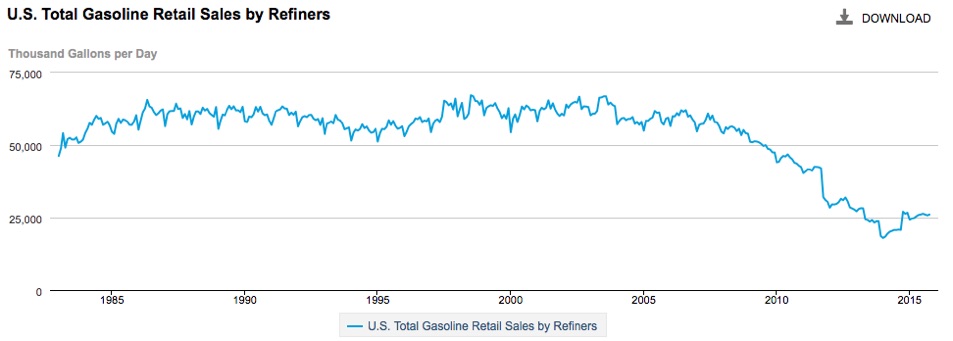
25 million gallons burned in the U.S. per day
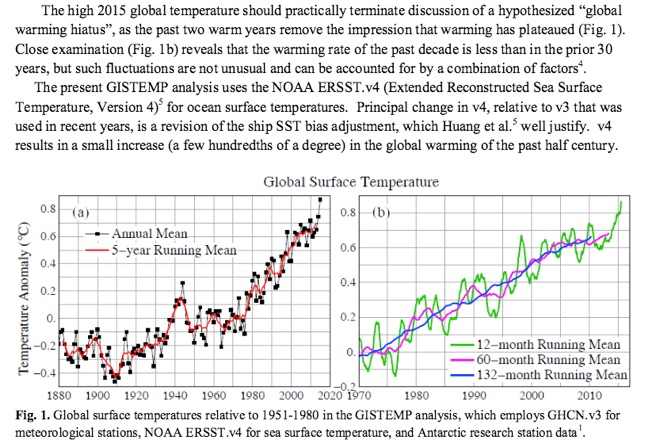
2015 Hottest Year “in the period of instrumental data.”
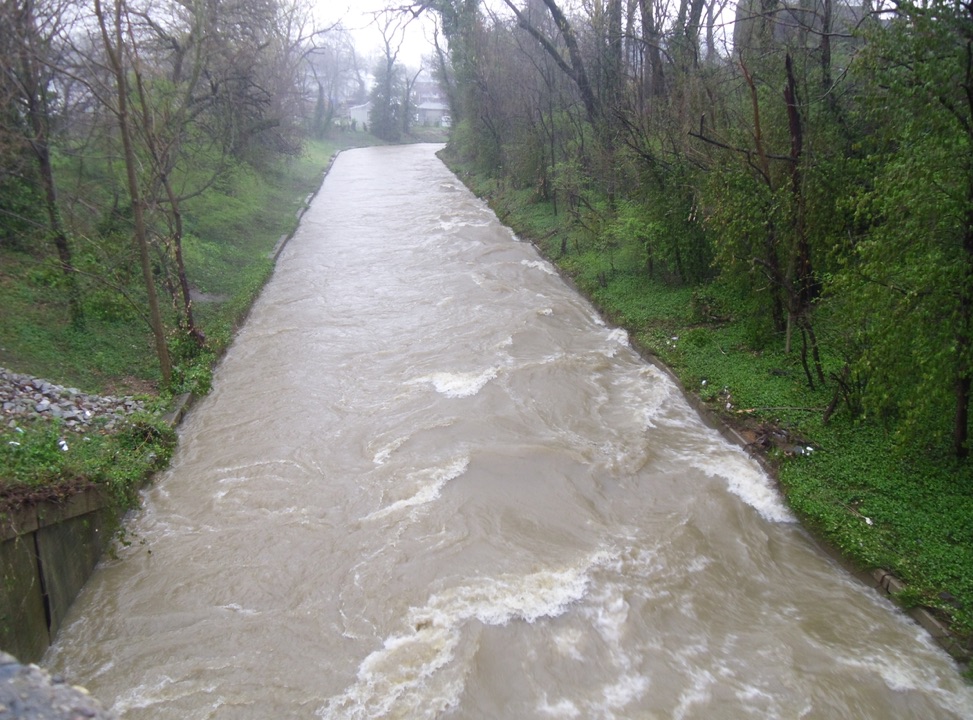
“We can also say with confidence, because of Earth’s energy imbalance (energy absorbed from sunlight exceeding heat radiated to space), that the present decade will be warmer than last decade.”
James Hansena, Makiko Satoa, Reto Ruedyb,c Gavin A. Schmidtc, Ken Lob
See it HERE
“Repeated rounds of heavy thunderstorms pushed April 2015 into the Top 4 wettest on record at the official climate sites in Louisville, Lexington, Frankfort, and Bowling Green.”
See it HERE
“Storms feed off of latent heat, which is why scientists think global warming is strengthening storms. Extra heat in the atmosphere or ocean nourishes storms; the more heat energy that goes in, the more vigorously a weather system can churn.” See it HERE
Below: April 2, 2015 storm nearly pushed South Fork of Beargrass Creek out of its concrete channel as viewed from bridge at Schiller Ave.
‘Smart city’ technologies
– Expensive projects that don’t solve urban sprawl, lack of access, walkability and climate change
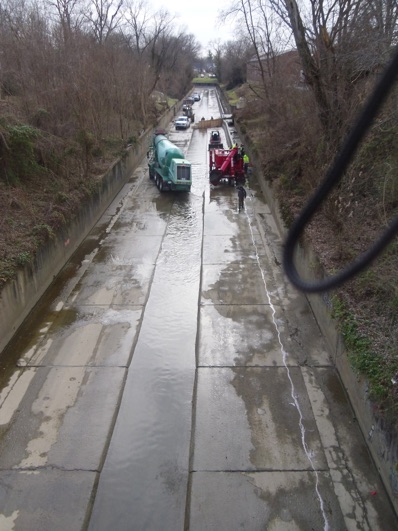
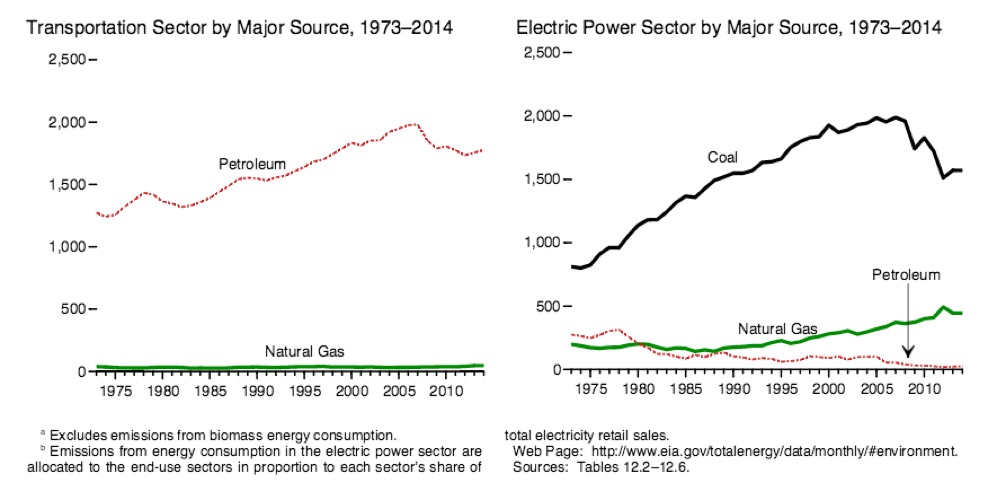
Carbon Dioxide Emissions From Energy Consumption by Sector
(Million Metric Tons of Carbon Dioxide) http://www.eia.gov/totalenergy/data/monthly/pdf/sec12.pdf
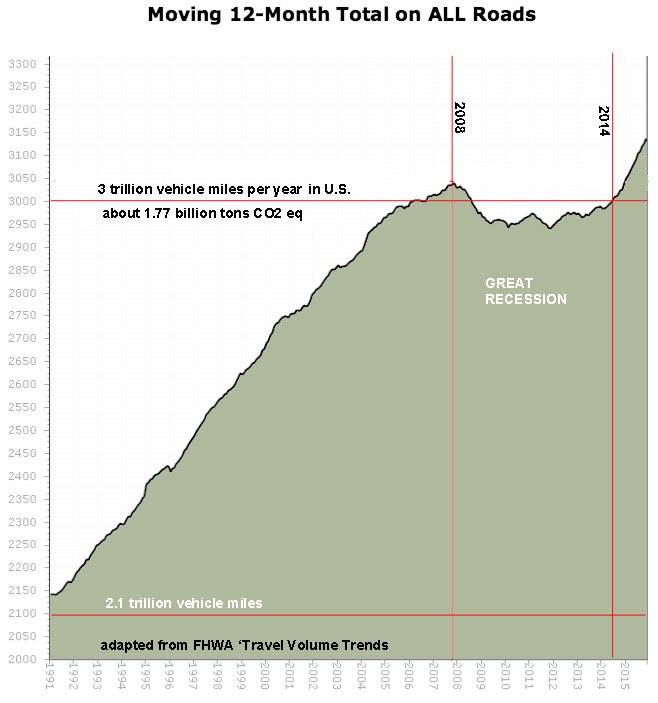
https://www.fhwa.dot.gov/policyinformation/travel_monitoring/tvt.cfm
https://www.fhwa.dot.gov/pressroom/fhwa1517.cfm
WASHINGTON –New estimates released today by the U.S. Department of Transportation’s Federal Highway Administration (FHWA) show that Americans drove nearly 3.02 trillion miles in 2014, the highest point since 2007 and the second-highest since data collection began 79 years ago, fueling calls for greater investment in transportation infrastructure to accommodate growing volumes of traffic.
The new data reaffirm projections made by U.S. Transportation Secretary Anthony Foxx in “Beyond Traffic,” his 30-year vision for transportation, which shows significant increases in gridlock nationwide unless changes are made in the near-term.
Americans drove an estimated 3.015 trillion miles last year, roughly the same distance as 323 round trips from Earth to Pluto.
http://www.eia.gov/todayinenergy/detail.cfm?id=20872&src=email
Estimated emissions of 5,404 million metric tons of CO2 from energy-related sources occurred in 2014, and energy-related CO2 emissions are projected to increase slightly in both 2015 and 2016. In the Reference case in EIA's recently released Annual Energy Outlook 2015, emissions are expected to increase only slightly, at a rate of 0.1% annually, and to remain below 2005 levels by more than 400 million metric tons in 2040. Future energy consumption and related emission levels will depend largely on a mix of weather, energy sources, and economic factors—as well as potential changes in national and state policies.
United States vehicle miles traveled each year
Automakers’ Smart Cities scheme is climate change denial at a critical time in history
March 8, 2016 by Bud Hixson
On February 4, 2016 Metro Louisville, Mayor Greg Fischer through his planning group, Louisville Forward, unveiled a proposal to invest millions in public funds to ‘transform surface transportation’ in Louisville. Automaker giants, FORD, TOYOTA, and digital communications players, influenced USDOT to incentivize investment in a national plan of ‘Smart car’ technology and infrastructure. Smart cars can detect potential collisions and either warn operators to avoid them, or ultimately --take control and drive the car into a safe path. The USDOT will announce in mid-March five winners of funding to develop urban transportation spending plans. A more than $ 100,000 grant will be given to develop a plan for Louisville if the application is approved.
Staking Louisville’s transportation future on the rapid integration of connected, automated cars s foolish. There are about a dozen reasons why this is so--but three stand out:
1) Car crashes --fatalities and injuries, lost work, impose a social burden on Louisville amounting to hundreds of millions per year. Due to the long phase in time--connected automated cars won’t bring substantial reductions in car crashes before 2030--the benefits in crash cost lowering will not be significant for 15 years--if they materialize ever.
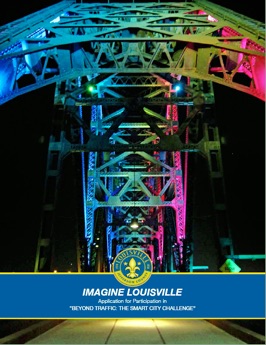
2)Auto loan credit debt has reached record levels. Much of the auto loan debt is to subprime borrowers. This shaky debt structure --like the subprime housing bubble that burst into an economic crisis and bailout in 2008--is poised to wreck more economic dislocation. The collapse seems likely to occur by 2020. This could lead a more general economic downturn due to high credit card and student loan debt. The public is not likely to be able to afford the new, expensive, connected, electric vehicles--adoption by private vehicle purchase could be delayed by perhaps a decade. Benefits in air emissions reductions and crash avoidance will be still more delayed by bad auto loan debt.
3)Spending billions on wired highways won’t provide the immediate relief expanding public transit could provide. Technical problems still have to be solved to put a nationwide fleet of autonomous, self driving cars on the highways. Sophisticated fiber optic digital sensor networks connected to urban data centers are necessary to realize the benefits. Technocrats in data centers will decide who gets fast lane access and who will be delayed or shunted to other routes. Connected and autonomous vehicles will be given special driving lanes while older cars--if they are still permitted, are excluded. An immediate investment in billions of dollars of wired highways and data centers does not immediately lower crash costs or greenhouse gas emissions and air pollution. Expanded transit reliably reduces all the ills in a shorter time frame at less cost.
LINKS TO OTHER PAGES
Way back in June, we noted that auto sales had reached 10-year highs on record credit, record loan terms, and record ignorance. We based that assessment on the following set of Q1 data from Experian:
•Average loan term for new cars is now 67 months — a record.
•Average loan term for used cars is now 62 months — a record.
•Loans with terms from 74 to 84 months made up 30% of all new vehicle financing — a record.
•Loans with terms from 74 to 84 months made up 16% of all used vehicle financing — a record.
•The average amount financed for a new vehicle was $28,711 — a record.
•The average payment for new vehicles was $488 — a record.
•The percentage of all new vehicles financed accounted for by leases was 31.46% — a record.
https://www.caseyresearch.com/articles/the-next-subprime-debt-crisis-is-coming
The Next Subprime Debt Crisis is Coming
Auto loan balances reached $1.008 trillion in the third quarter, an increase of $101 billion since the end of the same quarter last year, according to TransUnion.
The credit reporting agency said auto loans delinquent 60 days or more remained flat in the third quarter vs. the year-earlier period at 1.2 percent. Another 5 million consumers opened an auto account since the third quarter of last year, bringing the number of consumers with accounts to about 75 million.

“what happens when this bubble bursts just as auto inventories hit their highest levels relative to sales since 2009?”
Last quarter, the value of U.S. car loans grew by $39 billion...
“It was the 18th quarter in a row the car loan market grew.
The value of U.S. car loans now tops $1 trillion for the first time ever.
This means the car loan market is 47% larger than all U.S. credit card debt combined.
Car buyers are borrowing as much as they can. The average loan for a new car purchase hit $28,524 during the second quarter, its highest level in five years.
Consumers are also taking out loans with extra-long terms. The average term for a new car loan is now 67 months. For a used car, it’s 62 months. Both are all-time records.” Justin Spittler, Casey Research
“Subprime loans make up 40% of the auto loan market. The Wall Street Journal explained just how quickly the subprime market is growing.
Over the six months through September, more than $110 billion of auto loans have been originated to borrowers with credit scores below 660, the bottom cutoff for having a credit score generally considered “good,” according to a report Thursday from the Federal Reserve Bank of New York. Of that sum, about $70 billion went to borrowers with credit scores below 620, scores that are considered “bad.”
In other words, subprime loans made up 64% of new auto loans during the second and third quarters.”
Subprime auto loan delinquencies hit six-year high

Imagine Louisville’s Timeline could build the Dixie Highway BRT in four years. The full autonomous vehicle system is decades away. Because of the slow adoption of low or no emissions vehicles, greenhouse gas emissions will increase even as we spend billions of dollars on wired highways and data centers. Less than 50 % of vehicles will be low emissions by 2030.
In practice, the CLIMATE CHANGE mitigation of Smart Cars is a hoax. Fossil fueled cars will remain the main transportation energy in a time of global climate crisis. This at the least, is irresponsible policy.
The Smart Cars program would require $ 7.5 billion in new cars sales (300,000 cars times $ 25,000 each) to reach 30 % of the Metro Louisville vehicle fleet. With an auto loan debt crisis looming, is this realistic ?
The City and state will program billions in highway funds to private contractors to wire the highways and build tax-exempt data centers run by private contractors. The net result is continued car crash fatalities, increasing air pollution and disease and continued congestion costs and GHG emissions.
Smart Cities is a Dumb Idea designed by automakers and gasoline retailers.
Together, traffic congestion (estimated $860 million) and car crash fatalities ($ 935.8 million) and injuries burden Metro with more than $ 1.8 billion dollars in annual crash and congestion costs. Tragically Metro drivers consume about 730 million gallons of gasoline annually– amounting to more than $ 1.3 billion dollars of automobile fuel each year.
Over 34 years, to 2050, Metro drivers will have paid
$ 61 billion in comprehensive crash costs and congestion costs, plus another $ 131 billion for motor vehicle fuel for a total of about $ 192 billion in automobile transportation and impacts to 2050.
A full blown three route light rail system is estimated to have initial capital cost of about $ 5.6 billion dollars. For about 4 % of what Metro drivers and government will expend otherwise, on dirty cars a robust light rail system could avoid some $ 11.2 billion crash, congestion and fuel costs to 2050.
Estimated savings for a three route light rail line shifting 70,000 drivers to transit per day are $ 60 million in annual fuel costs and a significant share of crash and congestion costs. A 15% reduction in those cost would provide savings of $ 270 million each year. Annual savings of $ 330 million or $ 11.2 billion over 34 years would fund annual transit operations costs of $ 40 million and capital debt payments.
It has not been monetized in Louisville, but rapid reductions in congestion emissions and greenhouse gas emissions would reduce air pollution related illness and mortality and mitigate climate change and heat island costs. Coupled with the expected 15-20 year adoption of electric low emissions vehicles, a transit plus electric vehicle strategy is the most energy and cost efficient transportation policy for Louisville and other similar cities. Louisville leaders have flunked their leadership classes. We cannot continue to sacrifice our children’s future on the altar of big engineering boondogles–like Smart Cities.

In 2009, the IEA International Energy Agency forecast that current transportation policy is unsustainable and would lead to catastrophic global warming from carbon emissions by 2050 if the contribution of transportation carbon emissions were not lowered.
This an excerpt from Transport, Energy and CO2, Moving Toward Sustainability, published in 2009 and available on the web:


International and U.S. policy makers driven by this scenario crafted a series of 'Road Map' policies that integrated heavy influence from automobile makers and projected continued heavy industry production of light motor vehicles. The goal is an increasing share of low emissions electric vehicles –up to 50 % annual global sales share by 2050. Multiple studies demonstrate market penetration by electric vehicles is not enough and it must be coupled with shifting more commuters to light rail to achieve lowered emissions goals. But, Road Map policies focusing on selling more electric vehicles have come to the forefront of policy implementation. In Louisville this has resulted in the Imagine Louisville proposal to invest heavily in building infrastructure to subsidize electric vehicle sales. The three Bus Rapid Transit proposal for Dixie Highway, Bardstown Road and Broadway proposed in Imagine Louisville, will provide at most, a .3 % mode shift in daily VMT -vehicle miles traveled in Metro Louisville. The graph below predicts phase out of gasoline fueled vehicle annual sales by 2050. But many will remain on the road.

In 2016, sales of electric vehicles in the U.S. is tens of thousands --not millions. The benefits of electric vehicles of lowered emissions don't accrue substantially until 2040 or later– too late for the critical climate change period between 2016 and 2030. To avoid catastrophic climate change impacts --if we still can--more carbon reductions from transportation have to be achieved. A mode shift to light rail and other public transit, high efficiency, low energy modes must occur. More vehicles –of any kind– on already congested roads means more CO2 dirty concrete, tire wear air pollution and road salt water pollution.
"If the historical growth in vehicle miles traveled were to prevail, today’s 3 trillion vehicle miles in the United States would more than double by 2050. Slowing or stopping this growth in vehicle use while still meeting the desire for accessibility is a tremendous challenge that will necessitate changes in the transportation culture."
Two Billion Cars: Driving Toward Sustainability, by Daniel Sperling and Deborah Gordon, Oxford University Press
Backed by the automobile industry, the dominant planning paradigm is emerging in U.S. and global policy as a strategy to downplay the benefits of light rail to achieve rapid congestion and greenhouse gas emissions relief and instead push for an expanded market in electric, connected and finally autonomous vehicles. See IEA Roadmap:
"The Electric and Plug-in Hybrid Vehicle (EV/PHEV) Roadmap for the first time identifies a detailed scenario for the evolution of these types of vehicles and their market penetration, from annual production of a few thousand to over 100 million vehicles by 2050. It finds that the next decade is a key “make or break” period for EVs and PHEVs: governments, the automobile industry, electric utilities and other stakeholders must work together to roll out vehicles and infrastructure in a coordinated fashion, and ensure that the rapidly growing consumer market is ready to purchase them. The roadmap concludes with a set of near term actions that stakeholders will need to take to achieve the roadmap’s vision. It is the IEA’s hope that this roadmap provides additional focus and urgency to the international discussions about the importance of electric-drive vehicles as a technology solution.
Set targets for electric-drive vehicle sales. To achieve the roadmap’s vision, industry and government must work together to attain a combined EV/PHEV sales share of at least 50% of LDV sales worldwide by 2050.
By 2020, global sales should achieve at least 5 million EVs and PHEVs (combined) per year. Achieving these milestones will require that national governments lead strategic planning efforts by working with “early adopter” metropolitan areas, targeting fleet markets, and supporting education programmes and demonstration projects via government-industry partnerships.
Additionally, EV/PHEV sales and the development of supporting infrastructure should first occur in selected urban areas of regions with available, low GHG emission electricity generation."
But see, a perceptive and dissenting view--Paula Reeves in January 2016 Strong Cities:
http://www.strongtowns.org/journal/2016/1/19/keeping-the-dream-of-the-60s-alive
"Here is a final thought summing up State DOTs and their efforts to maintain the status quo in road building in spite of talking a good game about multi-modal transportation. I recently had the opportunity to attend the 60th Annual National Transportation Management Conference hosted by the American Association of State Highway Transportation Officials. What I heard at this invitation-only meeting for America’s state transportation leaders terrified me; self-driving vehicles and drones are our nation’s transportation future. There is no paradigm shift in their vision. No change is anticipated or seen as necessary.
Is this what is really best for the nation, our states, or our communities? We must explore this question in a national dialog that is independent of transportation agencies. If we don’t, these agencies, still pushing toward goals established in the 1960’s, will most certainly answer it for us."
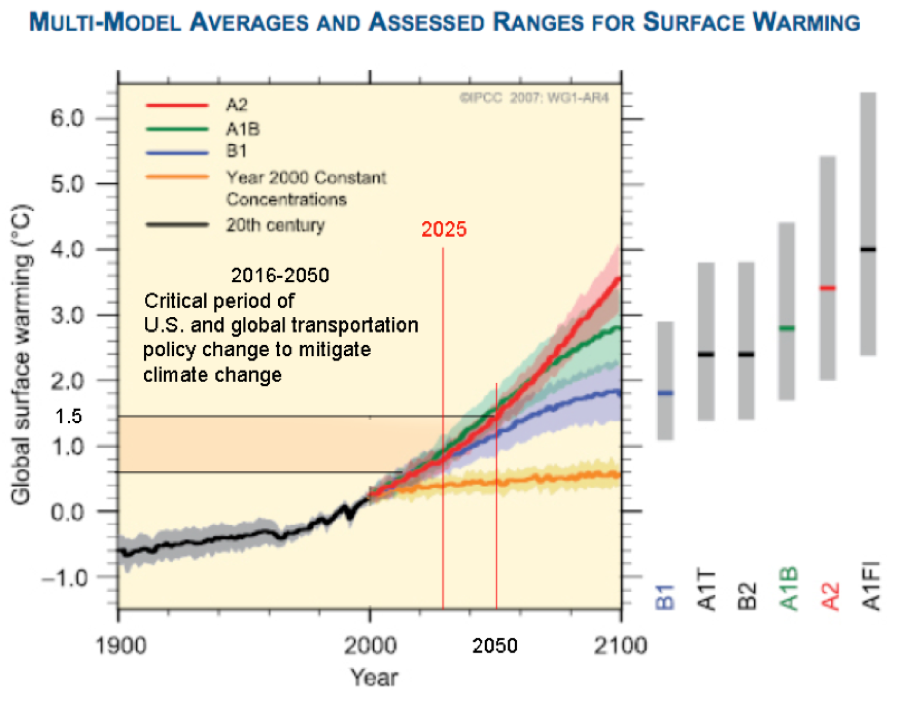
https://www.ipcc.ch/publications_and_data/ar4/wg1/en/spmsspm-projections-of.html
"For the next two decades, a warming of about 0.2°C per decade is projected for a range of SRES emission scenarios. Even if the concentrations of all greenhouse gases and aerosols had been kept constant at year 2000 levels, a further warming of about 0.1°C per decade would be expected. {10.3, 10.7}
Continued greenhouse gas emissions at or above current rates would cause further warming and induce many changes in the global climate system during the 21st century that would very likely be larger than those observed during the 20th century. {10.3}"
In the 34 years between 2016 and 2050, if Louisville does not reduce transportation energy use it will have emitted 224.4 million tons of transportation related CO2 based on 2015 emissions of 6.6 tons per year.
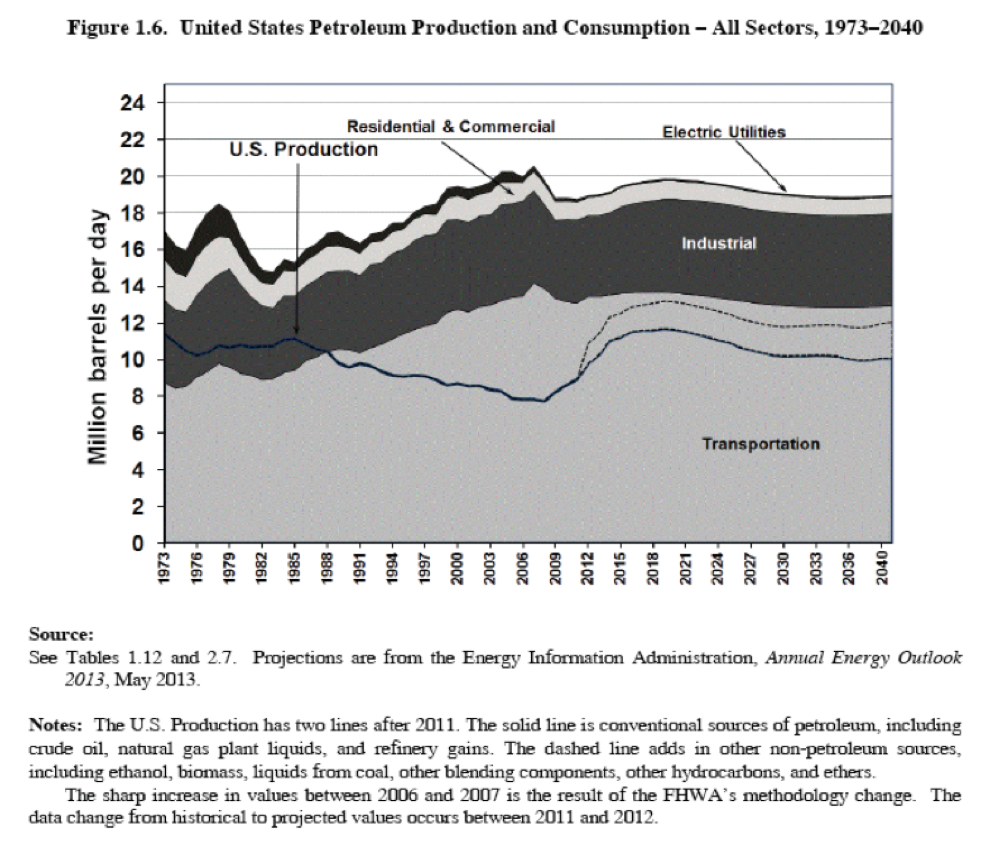
Metro drivers will have bought and burned some 70.5 billion gallons of gasoline based on 2,074,250,000 gallons of gasoline used in 2015. At $ 1.86 per gallon, Metro drivers will have paid $ 131 billion for fuel.
Louisville can afford to invest in a more energy efficient and emissions reducing transportation mode alternative. In its study Low Emissions Zones: Simulation of Behavioral Impacts Applications for the Environment: Real-Time Information Synthesis (AERIS) Program, September 24, 2014, the US Dept of Transportation modeled various transportation mode alternatives for reducing emissions and congestion. The study determined high congestion and pollution zones in urban Phoenix and traced back the causes including an influx of suburban traffic from outer ring commuters. It concluded that emissions and congestion could be best reduced by offering a transit mode like bus or light rail in addition to increasing low emissions electric or hybrid automobiles:
"There is a 3% to 5% energy and emissions savings at modest levels of eco-vehicle penetration coupled with enhanced transit services."
In the real world, automobiles on the road have an average age of 11.4 years. Electric vehicles purchased by individuals to replace aging cars will not likely comprise more than 40% of the total vehicle fleet by 2050. Gasoline and automotive fuels consumption are not expected to peak before 2030.
The present transportation system is horribly inefficient,
It damages the environment, the public health and its annual and cumulative costs are so great that the capital cost of significant transit system innovations can be offset by the savings. Major investments in expanding public transit pay for themselves in off balance sheet public health and environment protection.
Together, traffic congestion ( $860 million) and car crash fatalities ($ 935.8 million) and injuries impose more than $ 1.8 billion dollars in annual costs to Metro Louisville citizens and institutions. Over 34 years Metro drivers will have paid $ 61 billion in comprehensive crash costs and congestion costs, plus $ 131 billion for motor vehicle fuel for a total of $ 192 billion. Shifting just 30 % of daily commuter traffic to a fixed light rail system is projected to cost:
78 miles of track and (50) - 90 foot long articulated cars -30 year vehicle life span - 175 person full capacity each, $ 3.83 million -- $ 191.6 million total for 50 light rail cars
78 miles of track @ $ 70 million per mile = $ 5.4 billion
Total capital cost of building a three route Louisville system --$ 5.6 billion.
16.8 billion Btu fossil fuel burning cars on the road versus 589.8 million Btu light rail routes to do same amount of annual people moving is where public transit shows its advantage.
Light rail requires just 3.51 % of automobile Btu comparing single occupancy vehicles to full occupancy light rail double cars holding 320. The full savings from a light rail transit system are very significant and address each aspect of the Smart Cities Challenge.
Public transit expansion is a real plan to address climate change --not an irresponsible hoax.
Sales of electric powered vehicles have been falling since oil prices plummeted.
http://www.autoblog.com/photos/hybrid-electric-vehicle-market-share-vs-gas-prices/#slide-3472152
Green-Car Decline: Combined Hybrid, Electric Sales Started Falling Last June
•In 2014, there are in the range of 804 million cars on the road globally. They are consuming roughly 1.4 trillion litres of gasoline annually.
•In the moderate scenario, in 2020, cars will consume 27% more litres of gasoline in total annually than in 2015; in 2025, 51%; in 2030, 71%. They will consume less gasoline than if electrification was not underway to the tune of 2%, 4%, and 11% respectively.
•In the fast electrification scenario, in 2020, cars will consume 25% more litres of gasoline in total annually than in 2015; in 2025, 42%; in 2030, 46%. They will consume less gasoline than if electrification was not under way to the tune of 3%, 10%, and 24% respectively.
•It will take to until 2035 in the moderate scenario for global gasoline demand to peak, and by 2050 (assuming even greater penetration of electrics) demand will still be higher than in 2014.
•Under the fast scenario, demand would peak around 2029 and it won’t be until 2040 when demand starts decreasing from 2014 levels.
National and local transportation policy has been dominated by stupid politicians serving the multi-billion dollar auto transportation complex. That abdication of rational transportation policy translates into billions of dollars in climate disaster costs and lost lives yet to come. Smart Cities must be denounced and exposed as climate denial at a critical time in history. Transportation policy is everyones business.
Transportation Energy Data Book 32 Edition Vehicle Technologies Office, Office of Energy Efficiency and Renewable Energy,
U.S. Department of Energy

Radioactive Hat
by Rebecca Morgan,
8 x 10 inches, watercolor and graphite on paper.
Image courtesy of the Artist.
How about ‘complete information streets‘ ?
ith a truck load of bombast, the municipal propaganda machine rolled out the latest announcement that Louisville is mired in 60s era transportation planning last week.
Titled ‘Move Louisville’ the 2035 Transportation Plan’ released April 14, 2016, falls far short of being the progressive sustainable transportation transformation that the city needs.
A suggested key to understanding
Move Louisville:
•governmental units in north america have been captured by heavy industry and use public money --both tax revenues and bonded indebtedness-- to build infrastructure to subsidize local industry;
•the rise of the public relations industry has seen a corresponding dumbing down of public consultation processes as cities use modern risk avoidance and message framing techniques to disarm critical opposition and bury key health risks in green sounding phrases-like Vision Zero;
•Move Louisville employs outdated air emissions measures, fails to identify major transportation related health impacts and provides no yardstick for measuring performance of projects planned for the next 20 years against the threat of climate change and the social burdens of the health impacts of the single occupant vehicle system.
W

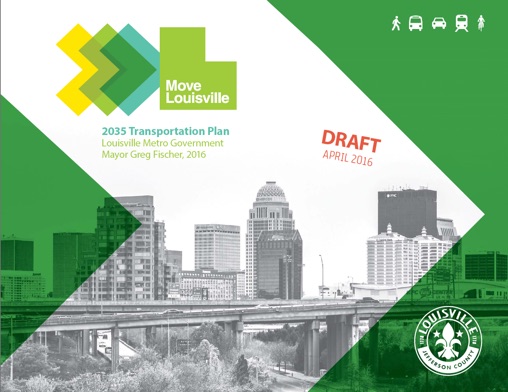
More than two years of public input to Move Louisville has left the community back at the starting line with little improvement in public transit ridership and a city that remains a marketplace for fossil fuel burning vehicles. Page 23 acknowledges that the public asked for transit system improvement:
“More than half of the comments received during the process
involved public transit. Improved transit choices clearly are on the minds of Louisville’s citizens.”
But since planning a major mode shift to public transit would affect the bottom line of the Kentucky auto manufacturing cabal, the Metro has to make sustainability noises while continuing to underfund public transit. The Mayor’s misleading public relations effort blames the community for failing to build dense neighborhoods that would support transit ridership. This is disingenuous on two or more counts:
1)In 1994, Community residents begged Metro Louisville to set urban boundary development limits to produce urban dense neighborhoods to support public transit--but the development sprawl lobby with Metro Mayor for life Jerry Abramson at the front, spiked any such smart growth limits. Instead we embraced multi-center sprawl with dirty air and high commuting vehicle miles per day as 70,000 commuters come from suburban developments into downtown. Now Move Louisville sheds crocodile tears for a system its leaders created.
“344,000 workers drove alone to and from their places
of employment, while just 3% commuted using public
transportation.”
page 31
The Move Louisville plan makes no significant change in this demographic. The supposedly erudite urban analysts lose the density and politics discussion in vague phrases as if it was an unsolvable problem at the mercy of market and social forces. The document speaks as though transportation project decisions happen by some mysterious process:
“However, the majority of the regional transportation
funding continues to be applied to new roadway construction or capacity projects with $37.4 million (61%) programmed for these projects in the 2015-2018 TIP. “ page 36
If transportation decisions are out of synch with what we need in the next 20 years--why Nelson/Nygaard--why?
The captured regional transportation planning agency KIPDA is populated by elected politicians and transportation officials. They cannot deviate from the market share protection policies of the Kentucky auto industry and expect to be re-elected or keep their jobs. The investment of the public’s money in road expansion as opposed to light rail systems is not an accident but a product of programmed political decision making. KIPDA and Metro politicians are sacrificing public health and environmental protection because auto dealers and gasoline retailers have more political clout.
2) Sprawl density didn’t happen by accident and the costs of failing to do rational regional transportation planning far outstrips any subsidies in public funding that we would invest in significant public transit projects. Density is a spurious metric to deny robust public transit planning. CART’s rough estimate is that the combined annual social costs in dollars of traffic congestion, traffic fatalities and injuries and transportation air pollution and morbidity exceeds $ 2 billion annually. Public transit systems lower the waste.
CART asked the Mayor to fund a peer reviewed study to more accurately monetize health impacts --but no study was done.
Spending billions of dollars to subsidize auto-centric transportation without understanding the billions wasted is the height of stupidity. Shifting 30 % or more of the daily commuters to light rail transit would pay for itself in reduced costs as well as lowering greenhouse gas emissions.
Move Louisville is a profoundly misleading document with deadly consequences for thousands of Metro residents. The statement on page 6 is a flat out lie:
“The Plan provides a path to a healthy, connected and sustainable
transportation network that encourages investment, growth and prosperity.”
The appropriate metaphor that emerges is the Pied Piper of Hamlin.
“The earliest references describe a piper, dressed in multicolored “pied” clothing, who was a rat-catcher hired by the town to lure rats away with his magic pipe. When the citizens refuse to pay for this service, he retaliates by using his instrument's magic power on their children, leading them away as he had the rats.”
Wikipedia
The City hired Nelson/Nygaard to lead us to a sustainable transportation system. But really Move Louisville is marching us over a cliff of wasted dollars, sick children and climate catastrophe. The Pied Piper Move Louisville document plays pretty sustainability notes while leading the local urbanist “green drinks” crowd away from asking the crucial questions like-- why are we stuck subsidizing an enormously expensive auto-centric transportation system, and what are its health impacts ? The path we are on is towards $ 40 billion wasted over 20 years.
“The more compact growth scenario recommended by Move Louisville could result in a decrease of over 500,000 VMT per day on the region’s road network.”
This blurb without supporting data shown, doesn’t compare that reduction to the 19 million estimated daily VMT for the Metro. In other words, the ambitious plans of the Fischer administration is a 2.63 reduction in existing VMT over 20 years. The Metro expects an increase in population over the planning period of 130,000 or more new residents. This could lead to 130,00 or more new vehicles on the road system. Given an average of 15 miles per day per vehicle, Vehicle Miles Traveled per day could increase by 1,950,000. We are going to see and increase not a decrease in VMT.
This reduction is not a “path to a heathy connected sustainable transportation network.” For most of the next 20 years, because of the failures of the Fischer government, we will spend $ 2 billion per year on crashes, congestion and disease that we can never get back. With rational transportation planning, we could invest in a robust light rail system that lowered pollution and connected people. It will take a lot of ‘green drinks’ to forgive the failures of the Move Louisville process.
The Plan intimates that the public will be steered to approve major transportation funding through bond financed and interest bearing debt for further connected -automated car projects in the future.
Establish public-private partnerships (PPPs) to improve mobility. PPPs are often used to finance large-scale capital projects. Forward-looking jurisdictions could expand their use of PPPs by adopting pay-for-success models that specify particular mobility outcomes (for example, by setting a goal of a certain year-over-year increase in carpooling’s modal share in a particular corridor) rather than the
means by which those outcomes are to be achieved.
As the articles below discuss, this is another boondogle.

“Cars will remain
the dominate mode of transport”
Mayor Greg Fischer Move Louisville Introduction
A population increase of 130,000 people over the next 20 years would add at least 130,000 new vehicles to the Metro Louisville roads. These same roads are already so congested that Texas Transportation Institute estimated we waste $ 860 million dollars every year on congestion fuel and lost time. Louisville Metro has about 1,042,766 registered vehicles now and another 130,000 would be an increase of about 11% and thus an increase in average vehicle miles traveled of 11% meaning we would go from 19 million miles per day in Louisville to 21 million miles of vehicle travel per day.
“If growth continues at current patterns, Louisville is projected to add around 130,000 new residents over the next 20 years, and we plan to grow faster than this to enhance our economic competitiveness in an increasingly global economy.”
“Today, almost 82% of commuters in Louisville drive to work alone, and 89% of households have access to one or more cars. Clearly, moving by car dominates today’s landscape and will for the near term.”
The more compact growth scenario recommended
by Move Louisville could result in a decrease of over 500,000 VMT per day on the region’s road network.
This scenario will help make households, especially lower income households, more mobile and provide more viable options for connecting to jobs. Many cities, including mid-sized cities, are pursuing light rail premium transit. Louisville explored light rail transit in the early 2000s, but was unable to achieve the political and financial support to execute thesystem. Today, Louisville must both increase density within its centers and address sustainable funding to support fixed-guideway transit. Move Louisville’s policies and priority projects aim to address these challenges over the next 20 years so that fixedguideway
service becomes feasible. Given today’s
constraints, Move Louisville recommends Bus RapidTransit be the mode to achieve premium transit service.”
page 9 MoveLouisville
Between the years 2010-2014, Dixie Highway experienced 34 traffic related fatalities within the projectlimits. This results in a fatal crashrate that is over 3 times the rate of similar roadways.
Page 13
Due to the concentration of destinations, employees, and agrowing residential market, Main and Market Streets in downtown Louisville may hold the potential for anew fixed-guide way service, such as a street car. Thestreet car could supplement and be integrated with theZero Bus circulator service now in place. Additional
analysis is needed to determine if the land uses alongthe corridor can support a street car, and if its benefitsexceed the capital and operational cost of the service.
Page 17
“Complete Streets are streets that work for everyone in the community, regardless of how they get around. Thisdoes not mean that every street requires bike lanes,transit lanes and elaborate streetscapes. It meansthat the multiple ways people get around are safe,comfortable and integrated.”
page 18
The more compact growth scenario showed a VMTreduction of over 1/2 million miles per day on theregion’s road network. Such a reduction results inbetter air quality and less congestion. In JeffersonCounty alone, annual VMT totaled over 7 billion in 2014.The associated transit options would be well used - themodeling suggested around a 40% increase in transitridership for the more compact growth scenario. Manyof the infill nodes themselves also showed the potential
for more than 10% of commute trips to be on bicycle.
page 19
The Move Louisville document is profoundly misleading and there will be blood on the ground ultimately because we failed to comprehend and meet the challenge of our times.
In 2016 in Louisville the Kentucky Auto manufacturing and retail gasoline selling lobby have again derailed critical transportation planning decisions that would preserve the future health and well being of our community. Instead Mayor Fischer is embracing a Mad Max future where the poor are isolated in urban ghettos and the elite continue to drive about in armored V-8 vehicles with chrome testicles hanging off the rear bumpers.
MoveLouisville doesn’t carefully lay out the scientific, social and environmental context that is the background for regional, national and global transportation planning.
Designed by public relations idiots, the ML document uses colored graphics to charm the eye starting with the dramatic arrow design on the front-- meant to impart the feeling that the plan is a smart, dramatic program for an exciting future. What rubbish.
I notice that since the various state federal and local agencies started using public consultation as a chance to pay big bucks to facilitators, graphic designers and smooth talking heads—since the 80s—they have lost the ability to build a serious and truthful study that reflects reality.
The strategy today is to create a new sort of concerned urbanist that is excited about
‘complete streets’ but doesn’t want to know about the ultra fine particulate emissions of
the vehicles that bikers and hikers are sharing the street with. Its amazing—we think we will build heavy traffic boulevards with increasing traffic and diesel buses and somehow its ‘urban progressive’ if you add a bike lane.
MoveLouisville doesn’t tell walkers and cyclists that they are breathing air with heavy particulate concentrations when they cycle down complete urban streets behind diesel trucks and buses. Concentrations of 123,638 ultrafine particulates per cubic centimeter are found on urban ‘complete streets.’
The type of urbanist favored by Fischer doesn’t mention climate change or UFP or
push light rail. Instead he favors paying millions to put some park benches and colored paving blocks along the sidewalk. Sure streetscape improvements are good, – but when did we lose sight of the major issues?
The document says in the introduction and on pages 31-33 that population is going to increase by 130,000 in Louisville. In an auto-centric system that means an increase of at least 130,000 new vehicles added to
about 1,042,766 registered now. Instead of reducing vehicle miles traveled the Move Louisville failure to plan for light rail means an increase of about 11% in VMT. Increased emissions from transportation mean we won’t be able to meet the new 70 ppb. Ozone standard —we’ll be listed as a non-attainment zone under the Clean Air Act. That could reduce federal funds for transit projects — though the Clean Air Act hasn’t exactly been enforced when it comes to auto emissions.
The three BRT--Bus Rapid Transit ‘Premium Transit’ routes --Dixie Highway, Bardstown Road and Shelbyville Road won’t shift significant ridership out of cars and into TARC buses. I estimate a ridership mode shift of .7% total for all three lines. The plan doesn’t have funding to build any but the Dixie BRT line and the others are not expected to be built til near the 20 year end of the planning period.
MoveLouisville should have framed the discussion with congestion, car crash and injury and traffic air pollution morbidity and mortality costs from the outset. Auto transportation is a public health menace costing the city some $ 4 billion dollars per year that can’t be recovered.
Characterizing the spatial distribution of ambient ultrafine particles in Toronto, Canada: A land use regression model
Scott Weichenthal, Keith Van Ryswyk, Alon Goldstein, Maryam Shekarrizfard,
Environmental Pollution 208 (2016) 241e248
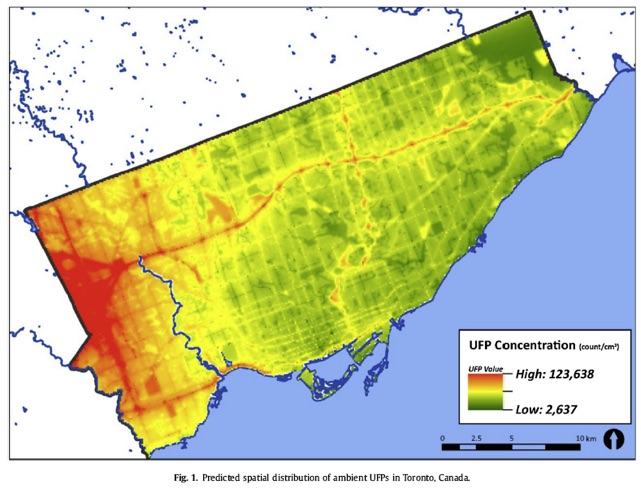
This is not an appropriate plan to get ready for the climate change rules that will be coming.
Transportation planning and project approval in Metro Government and KIPDA has been corrupted and controlled at the highest levels by the Kentucky auto manufacturers who manipulate the public process and use pliant politicians to secure new billions of dollars of subsidy for the automobile and concrete road system every year.
According to Open Secrets.org Ford Motor Company spent $ 10.5 million in lobbying in the 2014 election cycle. Locally the KY auto industry lobby claims $5.6 billion in vehicles and parts are made in Kentucky and 136,500 jobs are part of the sector. The stamp of the automakers is deep on the MoveLouisville process.
The public needs to know about the secret meetings between the Fischer administration, its contractors and the transportation industry giants.
The public interests and longterm Metro community health is not the same as protecting the profits of FORD, TOYOTA, Google or other profit seeking corporations. Rational transportation policy is in collision with fossil fuel dirty auto transportation.
Fischer has been running interference --between the industry giants and their demands that Louisville pay millions every year to support auto centric transportation-- and public advocates who decry the billions of dollars in wasted congestion costs, car crash and injury medical costs and asthma air pollution morbidity.
The MoveLouisville document is aimed at the latter group to put an appearance of fair public consultation on what was really a fixed-star chamber decision --that being to ignore global warming, ignore air pollution and car crashes and deep six light rail.
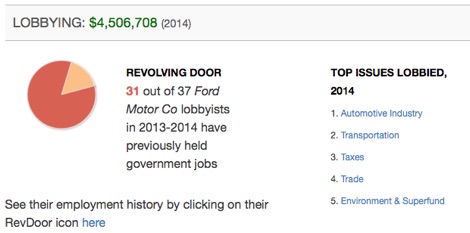
Neurotoxicology. 2015 Nov 21. pii: S0161-813X(15)30024-3. doi: 10.1016/j.neuro.2015.11.008. [Epub ahead of print]
Neurotoxicity of traffic-related air pollution.
Costa LG1, Cole TB2, Coburn J3, Chang YC3, Dao K3, Roqué PJ3.
Abstract
The central nervous system is emerging as an important target for adverse health effects of air pollution, where it may contribute to neurodevelopmental and neurodegenerative disorders. Air pollution comprises several components, including particulate matter (PM) and ultrafine particulate matter (UFPM), gases, organic compounds, and metals. An important source of ambient PM and UFPM is represented by traffic-related air pollution, primarily diesel exhaust (DE). Human epidemiological studies and controlled animal studies have shown that exposure to air pollution, and to traffic-related air pollution or DE in particular, may lead to neurotoxicity. In particular, air pollution is emerging as a possible etiological factor in neurodevelopmental (e.g. autism spectrum disorders) and neurodegenerative (e.g. Alzheimer's disease) disorders. The most prominent effects caused by air pollution in both humans and animals are oxidative stress and neuro-inflammation. Studies in mice acutely exposed to DE (250-300μg/m3 for 6h) have shown microglia activation, increased lipid peroxidation, and neuro-inflammation in various brain regions, particularly the hippocampus and the olfactory bulb. An impairment of adult neurogenesis was also found. In most cases, the effects of DE were more pronounced in male mice, possibly because of lower antioxidant abilities due to lower expression of paraoxonase 2.
The study highlights that concentrations of fossil fueled exhaust particulates of ultrafine size coincide with transportation corridors.

Tire wear particulate ground into the concrete entry ramps at a downtown Louisville parking garage. See Tire Wear article HERE